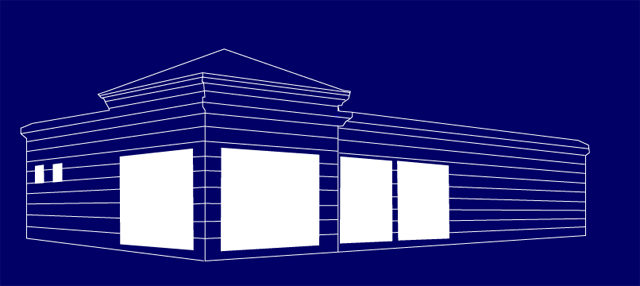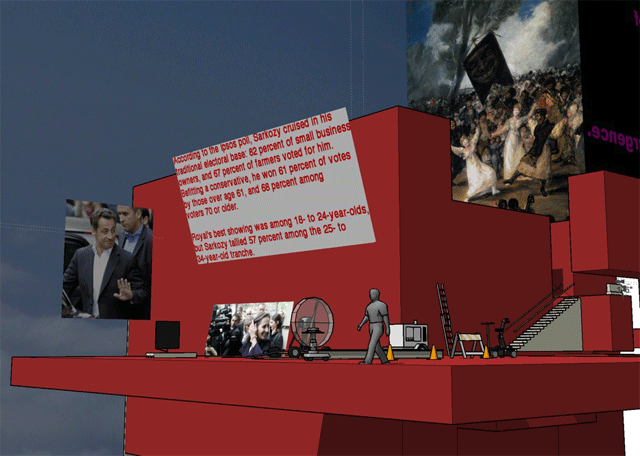May 30, 2007
Install Day

Hiroshi and I are overseeing the deinstall-install of our work at Tomio Koyama Gallery.
A train of images follow the jump...
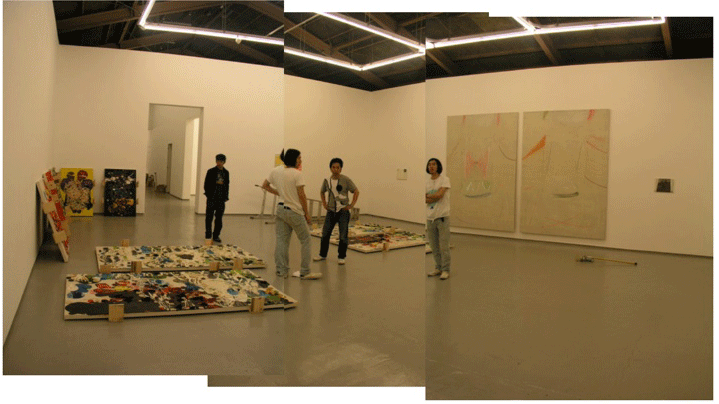

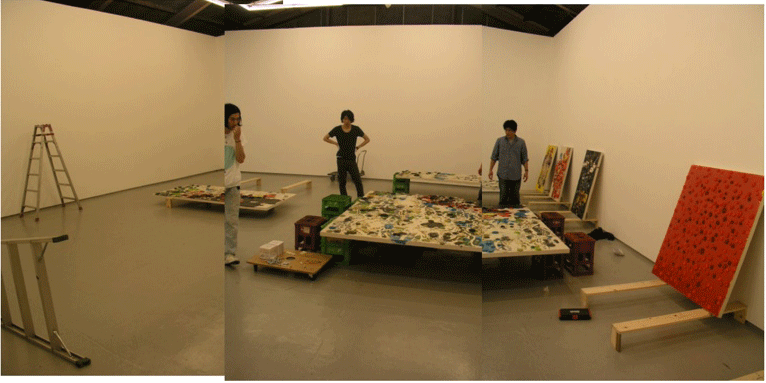

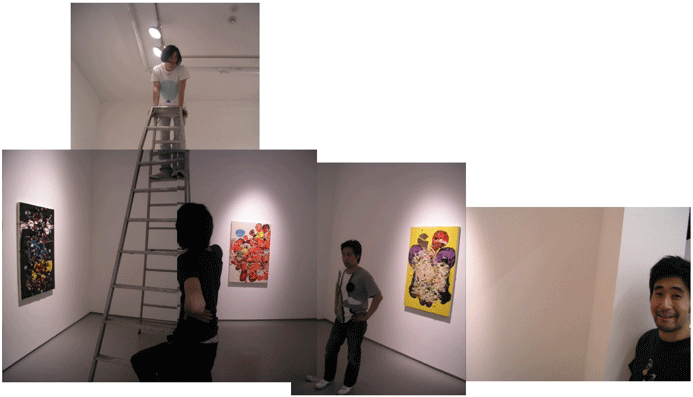


TCAT

I arrived after 8pm last night, it has been raining in Tokyo. I love this place. This is an image of TCAT, Tokyo City Air Terminal, a hub for bus transportation to Narita Airport, about an hour out north of the city. My hotel is just around the corner, a place I have stayed in before. I like feeling familiar here.
Tomio, Hiroshi Sugito and Tomoko, Tomio's assistant and I had dinner nearby at a place where Tomio grew up. Many courses, stews and sashimi and sweet potato vodka. A tray of blow fish flesh, Tomio reassured me that the cook was licensed to do the job. Very nice.
Morning has broken, I'm about to step off to the gallery for my fist look at it and the state of arrival of the paintings.

May 29, 2007
Oliver Twist
For those who haven't seen it yet, here's Roberta Smith on the debut of Joel Mesler's Rental Gallery NYC:
OLIVER TWIST
Rental
120 East Broadway, at Allen Street, Lower East Side
Through June 16Rental, the latest addition to the expanding Lower East Side gallery scene, is the first one to have the light and views ? if not the interior design ? of a Chelsea space, thanks to its location on the sixth floor of a corner building with big windows. But that is not its distinguishing characteristic: true to its name, and like its predecessor in Los Angeles, Rental is for rent to selected out-of-town dealers. The first Rental was founded in 2005 by Daniel Hug and Joel Mesler; the New York version has been set up by Mr. Mesler.
This could unsettle the gallery scene?s home-away balance of power in interesting ways. Dealers who give artists their first shows elsewhere will not necessarily have to hand them over to New York galleries to obtain exposure here. They can do the work, walk the walk and talk the spiel themselves.
The next show, opening June 23, will be organized by Trudi, who runs a tiny space in Los Angeles. This fall brings the Cologne dealer Christian Nagel, followed by Sister Gallery and the Black Dragon Society from Los Angeles and Raster Gallery from Warsaw.
In any event, Rental?s inaugural exhibition, a group show called ?Oliver Twist,? is an ecumenical, seemingly rushed mishmash of work by 29 artists ? all represented by future renters of Rental ? that ranges from figurative to abstract and from oil on canvas to whatever. The better-known participants include Chris Johanson, Evan Holloway, Katie Grinnan, Jason Meadows and Rebecca Quaytman, and all the efforts confirm that the current direction of contemporary art is anyone?s guess. ROBERTA SMITH
She has pretty much nailed it.
May 28, 2007
Title Time: Paintings

What follows is a list of paintings with titles hyperlinked...

Whistling in the Dark
ww#
2006
Oil on Canvas over Wood Panel
50"x46"

Ubiquitously Unmentionable
ww#
2006
Oil on Canvas over Wood Panel
50"x46"

Colossus
ww#268
2007
Oil on Canvas over Wood Panel in four segments
8'x16'
Magpie Aesthetic
ww#269
2007
Oil on Canvas over Wood Panel
48"x32"

The Inner Structure of Our Intellect.
ww#270
2007
Oil on Canvas over Wood Panel
48"x32"

Ever Vigilant
ww#271
2007
Oil on Canvas over Wood Panel
48"x32"
Memorial Day

My father's life was framed by the Korean War. Fifty years separated a battle that wiped out 197 of 215 men and my father's eventual PTSD, in which uncontrollable flashbacks prompted his demise near the very anniversay of that massacre. I heard him speak of that day only once in my life. It was an abbreviated account.
He came to the position politically that the war was a waste and terrible and that no one in their right mind would want to bring it on. As time passed, I began to consider that he was speaking personally, that the war he experienced stole his life in some way. I told him of the large Korean community in Los Angeles, of how healthy and vibrant they are. I told him of hte satellite photos of the Korean pennisula at night, of how many generations of families have enjoyed happy lives as a result of his efforts so long ago. I was hoping that he might realize that his sacrifice had a purpose, that his pain purchased some measure of good in the world.
Tragically, I don't think he could feel where I was coming from.
I found a book that is a good dry historical account of what happened on that day, however fragmented as it is. I thought that a good way to co-memorate Memorial Day is to share the relevant bits with you after the jump...

He was stationed on Okinawa (in the 29th Infantry, Baker Company, 1st Battallion, 3rd Regimental Combat Team) when the North Koreans pushed south to the Pusan Perimeter, the small rump on the southeast end of the pennisula. Events were developing so rapidly, that we had to dump troops into a malestrom.
He was eighteen at the time.
The first reinforcements to arrive were 1/29 and 3/29 from Okinawa. The original plan was to train the two battalions in Japan for six weeks. within days, this was changed. MAJ Tony J. Raibl, XO of the 3/29 had been sent ahead to Japan, where he learned on July 20 that the two battalions of the 29th would not stop in Japan, but continue to Korea.......MAJ Raibl next was told that the battalions would have 10 days of "intensive field training" near Pusan. When he arrived in Taegu on July 22nd, Raibl had an extensive conference with GEN Walker. As a result of this meeting, the major understood that the battaliions would have three days at Pusan to draw equipment, zero and test fire weapons.
But when the two battalions unloaded at Pusan on the 24th, they were rushed to Chinju and attached to the 19th Infantry Regiment. They were allowed no time for anything. Rifles were not zeroed-in, nor crew-served weapons test fired. Some weapons test fired. Some weapons, such as the newly issued .50 cal machine gus were still in cosmoline. The perilous tactical situation on the southern front virtually dictated that these two commands be rushed there at once, otherwise the decision to rusht he 29th to combat in this fashion would have been criminal. As it was, both commands suffered crippling losses in their first battles.

Possibly contributing to troubles of both battalions was the fact that both of their commanders were new to their commands, and neither had combat experience. LTC Wesley Wilson (West Point 1929) , then 43, commanded the 1st battalion, LTC Harold W. Mott commanded the 3rd.My father curtly described the combat as that which happened in waves, of being mired in struggles in which anything in reach was used as a weapon. Knives and pistols and M-1 carbines spent and used as clubs, bodies stacked between assaults to form defensive positions. Ultimately, there were no words to describe the mayhem.On the afernoon of July 25th, the two commands arrived at Chinju. That evening, 3/29 was ordered to take Hadong, a road junction town 35 miles southwest of Chinju.

His commanding officer was LT John Hughes, a tree trunk of a man, whose character was oak. My father's abbreviated description of that time was an image of Hughes crawling down a hill; eyes wild, knife in one hand and a pistol in the other. My dad said "I made eye contact with LT Hughes and pointed to the Korean interpreter..." knowing that he was the key to find an exit from the slaughter, "...and I made maximum effort to get to him and cross the river." the only alternative out of the kill zone.
In all, LT Hughes had 215 men in his B/29th... was initially deployed on high ground west of Annui. The enemy attacked with superior forces from three sides, putting the Americans in desperate battle from the beginning. By nightfall on july 27, Co. B had been forced back into the town. Hughes planned to high ground across the Nam River east of town. Two officers and 16 (enilsted men) got across the river before enemy machine gun fire cut off the rest of the unit. These 18 men tried to help the others break out, finally, giving up and making their way through the hills to the 34th near Kochang.I don't know how long they were out in the countryside, escape and evasion, but it was over a week. He drew vignettes of stealing food from villages at night, approaching the sentry position at the perimeter of friendly forces with shouts of vulgarities to authenticate that they were Americans. He said that the food and shower there was the best he ever had.
Posted by Dennis at 8:48 PM | Comments (0)
May 25, 2007
Summer 2007

This summer starts after Memorial Day weekend with a flight out to Tokyo for my show that opens Saturday June 2nd. Much fun and wonder to ensue.
I'm only there for a week, sad to say. My natural resistance to tourista (strange, since both of my studios both here in Los Angeles and in Tossa are prime tourist sites) prevents me from going walkabout in that wonderful country. My calendar is rough, too. I have to factor the work I have to do both here in LA and in Tossa, and this keeps my hands from being idle too long.

A couple of months are all I can afford in the Costa Brava. ?Que lastima, Tio!. But I am looking forward to seeing our freinds there, burning the studio down in between snorkel runs and bar-b-ques and local music in the endless summer Tossa bar crawl.
I can smell the stone of our old house and the Mediterranean salt air already.
May 24, 2007
Memorial Day Weekend
Memorial Day comes this weekend.
(Via my favorite military news site, Strategy Page.)
PostScript: If this post was a little too kumbayah (my point being that a wobbly guitar solo has as much to do with nation building as a full metal jacket), check out this video from a British soldier in Afganistan who se camera captured what its like over there. At about 3 minutes into the video he got shot and he had to maneuver his vehicle and his crew to safety. He was gasping. You can tell that he was worried about the extent of his injury, from the character of his sputtered profanity. At 5 minutes his buddies check him out and they cheerfully inform him: "'Ave you been shot in the arse?" He stumbled to the rear for medical attention and his buddy leaned into the camera for posterity's sake, mockingly: "I've been shot in the ass!" with a cheerful leering grin that spoke of the relief that the wound was of no serious consequence.
Zygote
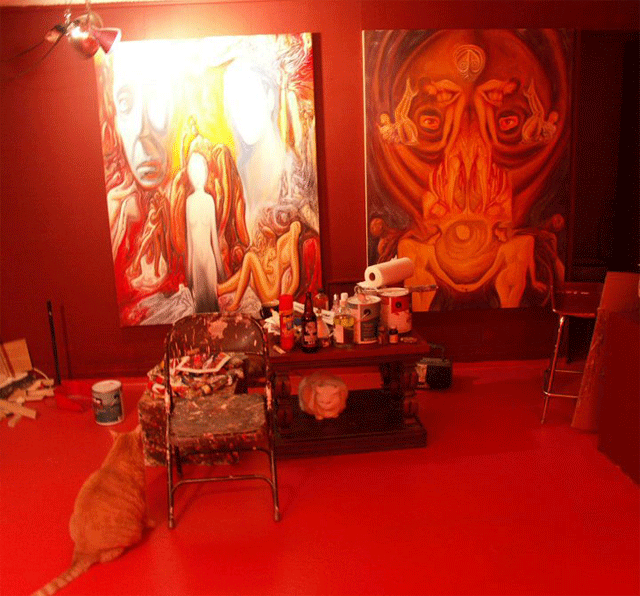
I'd like to see this in a show of this, complete with table piled high and cats too.
I'm glad Jacques is back playing the keyboard again.
Studio as womb, Jacques? I imagine your paintings with skin glistening like a zygote.
Oyster before the halfshell.
Time Machines (12 Movements)
Justin Moore showed this at Cirrus recently and I wanted to share it with you all. I find it inspiring. I like the processing of ambient sound into a kind of music by using the technology against the grain. It made fleeting moments a little more special.
The Big Issues

"The way the Angry Young Men became angry old men was not a pleasant sight":
Amis wanted to push Wilson off a balcony during a party ("Look, there's that bugger Wilson"). Of this incident, the author reflects, "For some reason I never quite understood, I seemed to arouse in Kingsley Amis the same deep uneasiness I could sense in Tynan." The explanation is not hard to seek. Wilson gets up people's noses because he has such a high opinion of himself: "I had taken it for granted that I was a man of genius since I was about 13."He is convinced that the animosity springs from envy - "The success of The Outsider must have galled him," he says of Canetti. But not even his in-laws took to him ("Get out of town, Wilson").
And is The Outsider still any good? Wilson's book was a bible for those post-war adolescents who scowled a lot and wore black polo-neck sweaters - dated beatnik stuff. He conveyed an autodidact's self-conscious passion for Nietzsche, Dostoyevsky and Hermann Hesse, artists "tormented by the questions of why we are alive and what we are to do now we are here".
Wilson didn't only write about outsider archetypes, he was one himself - and to prove it slept in a tent on the edge of a golf course in Whetstone. He suggested that only "people who feel alienated from a materialistic society" really address the big issues. I personally outgrew this in the sixth form, and have quite enough of "the chaos of existence", thank you, when a tin opener won't work.
May 23, 2007
Admin: MailCall
Doug Harvey wrote in to clarify a potential misconception induced by my inference that Tim Hawkinson employs an army of assistants in his studio:
Hey DennisClaro de agua, Doug!Just so you and Aaron are clear, Tim Hawkinson rarely uses any studio help or outside fabricators. For the tight deadline of the Getty/Nyehaus/PaceWildenstein hat trick, he had one part time assistant for the last few weeks before the NY openings, mostly to keep the Uberorgan functioning while he was out of town.
Keep the faith
DougH
Given the industrial strength aspect of Hawkinson's work, I hope I may be pardoned for the assumption that he must at least have people assisting him if not with the artwork itself, then with other aspects of his studio. He is of course a tremendous sculptor and he deserves the strong support that graces his career in LA and now NY.
Having defenders the likes of Doug Harvey come to your aid is strong support indeed. I think Doug Harvey is the best writer on art on the West Coast, second only to Dave Hickey in the West and in the very, very short list of writers nationally that I am automatically interested in reading when I see a new piece arise in print.
May 22, 2007
Women and the 21st Century
Thought police in Iran are trying to keep the women from modernity. This is happening all over the world, more or less, for all our lives and then some.
Tech note: I've just downloaded this video via TubeSock and imported it into my iTunes library.
May 19, 2007
Joanne Greenbaum in Chicago

Right about now (Saturday night), Joanne is toasting her show in Chicago, with work she created during her recent residency at Chinati:

All the best, Joanne!
Her report was that she had a so great a time, she would like to return. The solitude and small communtiy of artworld people made for a great environment to focus on her painting.
May 18, 2007
Ahora

Actually, this shot was taken last week, a fair approximation of a true you -are-there "Ahora" shot. The Southern California meterological phenomenon known as "June gloom" now graces LA with a nice wet blanket of clouds every morning, keeping the plants nice and juicy far into our hot summer, one of my favorite aspects of the ecosystem here.
Today's task: applying a sealant to the new wood fence, wood siding and also to our old deck. I probably should pay a professional to do this, but years of DIY and a tight wallet compell me to take it on myself.
It should be nice to hang out here as the sun arcs across the sky.

And that brown spot is my compost heap, shaped into a volcano form.
It's full of squirming worms.
May 17, 2007
LA Drive By

Sunset Boulevard at Grand Avenue.
I think this might be a Coop Himmelblau project.
May 16, 2007
Cup and Lip: Sunlight and Monads and Blooms

"There's many a slip betwixt the cup and the lip", so the saying goes.
And so much has slipped as the months have gone by, great stuff that I would have loved to have blogged if I had the time. But when it comes between painting and blogging, let the latter take the hindmost. As the schedule takes on the appearance of slack, I will take the opportunity to dust off great lost blogposts that should have made it up despite it all.

May 15, 2007
Reap The Whirlwind

New York in 72 hours.
My old friend Aaron Parazette asked if I would be interested in visiting the city with him, we could split a hotel and spend the whole time talking about art. My show was done and shipped, I had a small window of time that coincided with Aaron's need to conduct business in the big city. We could attend the Inaugural show of Joel Mesler's Rental Gallery.
Hell yea.
The intensity of New York comes from the sheer density of people of course. After the bump and push through the throng, one notices the erosion of the built environment: details broken, chipped, abraded, pulverization in slow motion. Human oil and grime that inevitably clings to it is everywhere and slowly I came to a realization that living above or below the line in this city boils down to the capacity to live with or without clean architectural detailing. A density of people means a density of information. Social intercourse is fast and furious, the data often a potential determinant of success or failure. Very little of what one encounters can easily be discounted without negative ramifications. Life there must be different for residents compared to visitors, habits of living can be streamlined and the noise can be edited, but the mind and body for the visitor is pushed to the limit.
It felt wonderful.
How can I relate this to you all? Let's try a diaristic approach... this is a blog, afterall.


What a great countenance Jason has.


He opened at Tanya Bonakdar Gallery. The show's title: "Frame Narrative" probably reflects the fact that Jason teaches theory at ArtCenter but I like the monstrous aspect of his work, how the things he makes reflects a bigness, a bearishness. Jason himself is a kind of monster in the most amiable way. The terminology of art theory makes sense to me in that it is a language that seeks to make sense of a world made chaotic by the processes of modernity... that Mary Shelly's Frankenstein is a metaphor of this modern world, of things broken and stiched together, scary and big and uncomfortable.

Then finally, there remains --for me-- the fact of Jason's generous spirit, encased in a mountain of hair and flesh and finally a big grin rimmed with huge gapped teeth and eyes that shine in a most fraternal way. I believe that all talk of philosophy and monsters in this work must finally reconcile itself with Jason's smile.

Aaron and I grabbed a beer at the front desk and joined the crowd out on the sidewalk. Joel Mesler was there, pensive about the inaugural show that was set to open in a couple of days; Phil Wagner flew in too, Sarah Lehrer-Graiwer appeared, Parker Jones and Ry Rocklin were on my flight. Everybody was getting oriented to the weekend opening to come. The agenda? Food, drink and a visit to the new Rental Gallery. Around the corner, we hailed a taxi bound for the Lower East Side.
I forget the name of the bar near the gallery, it had no sign and the design was minimal. Good food, tall beers and noise. The gallery was around the corner. Chinese barrio style, Joel's place was up six floors overlooking the corner of Allen and East Broadway.
Joel's whole enterprise had become quite a topic back at LA's ChinaTown for the past nine months. People took the full range of emotions and positions about whether Joel would succeed. Mostly, I think the pain stemmed from the loss of a vital force in Los Angeles, particularly ChinaTown. There was also the all-too-human capacity to become confused when someone changes within a social context. Joel had to grow and New York was the only place to grow into. Not everyone was comfortable with that.
Joel is fulfilling the mandate of our time: manifold, genre crossing, multi-media, many faceted and all that jazz. Joel grew up from a knucklehead artist raising hell after art school to a dealer and a gallerist and a publisher and a painter and an artist who uses business itself as a fine art medium. It's a fine artworld popular wisdom conceit --but ultimately, it's not for everybody and few people can do it well. The question of whether Joel could do it was still an open one for some back on the West Coast.
An echo of that question hung in the air as Thursday turned to Friday as we toured the sixth floor of the future Rental Gallery amid the boxes and shredded shipping materials, artwork scattered everywhere.

Aaron had business to conduct and I promised Joel to help install the show with Phil. During the day, other artists in the show and friends began to show up: Robbie Kinberg, Andrew Hahn. Everyone pitched in and as the first piece got hung, the show started to look like it had a possibility after all.

I cut loose from Joel's Rental Gallery in the early afternoon to visit my gallery (Nicole Klagsbrun) and say hello. I took a taxi since time was tight and on the way I caught a glimpse of the new IAC project by Frank Gehry. Looking like Superman's Fortress of Solitude, somehow the concertina wire in an adjeacent lot seemed appropriate. I admire Gehry's work of course, I cut my architectural teeth on his ouevre when I was young, but as always it is his detailing that consistently lets me down. Look at how the building meets the ground. I remember my first visit to LA's aerospace museum where the building was eroded, crumbling from human touch. Again, here is that idea of human corrosion, entropy. Buildings used to be fortified all over, then fortified at the parts that people reach --I think of my understanding of Louis Sullivan's distribution of ornament, within human range-- and now there is this guy from LA who's making buildings as fragile as paper, you just look at them and they age. Architecture as origami. Nice in theory but we don't live in theory, we live in fact. (Spoil sport.) Why wouldn't this kind of building be fortified at every point of human contact? And why would this particular place -where the sidewalk meets the building- not reflect and break down the spirit of the overall design into other harmonic levels of design techtonics? The building was built for the first photographs at the end of construction, it was made for a media existence. No other dimensions are neccessary, fugues are old hat. Dusty, antique Bach was meant only for the days of perfumed hankerchiefs and clockwork universes, not for our time of FTP downloads and 500 channel satellite TV.
But then again, Nicolai Ouroussoff might disagree:
But it is when you step onto the sixth-floor corporate terrace that you glean what?s missing from the design. Leaning back against the rail, you get your first close look at the glass cladding on the upper floors, at a point where the building narrows. The faceted geometry here is more extreme, the connections between the glass panels more awkward.(Emphasis Mine)Joints don?t line up perfectly; corners look hurriedly patched together. At certain points the unusual curvature of a window, created by the building?s odd geometry, makes it impossible to span the opening with a single piece of glass, and the additional mullion creates an odd, patchwork pattern.
The effect bristles with energy, as if the building were beginning to crack at the seams. It brings to mind early Gehry projects like the 1972 Ron Davis Studio in Malibu or the 1989 Vitra Design Museum in Weil am Reim, Germany. Neither work is perfect, but their imperfections are important. What you feel is someone struggling to make sense of something he has yet to fully grasp ? the incompleteness of the creative struggle.
It is a reminder that Mr. Gehry?s courage as an architect has stemmed in part from his distaste for perfection, for architectural purity ? which in his mind comes perilously close to oppression. His aim has been to redeem the corners of the world that we often dismiss as crude, cheap and ugly. He intuitively understood that what seems ugly now may be only unfamiliar. If the ideas underlying a design are strong enough, its beauty would eventually reveal itself.
The IAC building is elegant architecture. But it doesn?t make us rethink who we are.
So, bad detailing is actually ennervating, we get to rethink who we are.
It's like that line in Platoon: "Sheeit, gotta be rich in the first place to think like dat.".
*2

Young artist Barney Kulok had a show of photographs up at my gallery, Nicole Klagsbrun. To my eye, he exemplifies all that is good in a young artist today: preternatural, precocious, a traveller, open, introspective and gregarious. Video, photographs, different framing strategies, different approaches and different genres... I have often called for suppleness in the way we think about art and now that I think I detect a generation who are naturally supple in the way they manifest art. We may therefore be able to see a corresponding suppleness in the way we philosophize about it too.
The crew at the gallery were going to meet up at Beth Campbell's installation at 125 Maiden Lane in Downtown Wall Street later that night. With the rendezvous info in hand, Aaron and I met up to cruise the galleries for what was left of the afternoon.
Here is some of what we saw:

Metro Pictures, Sterling Ruby: "Killing the Recondite".

Aaron and I begin to talk about the need for the artist to awe an audience in an exhibition. The big question was, in this case, whether Sterling Ruby was doing this in a way that is an old way, something mannered, the shock and awe of a previous era; specifically, the language of a late 1980's avant garde?

Behind the ziggurat was a portal to hidden depths. Was Sterling Ruby hiding his hidden depths? Does he have to?


I salute what I see: manifold, genre crossing, multi-media, many faceted and all that jazz. But what I track is the way the artist's hand is constant throughout all genres that he is crossing.
And talk about an artist's hand....
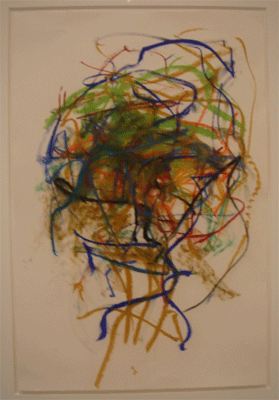
(Time is not on our side.)
We dropped into Cheim and Reed to see Joan Mitchell's show. August. Remarkable. Elegaic. A fortune in painterly details, scumbled passages coiled onto scumbled passages. A mind and body shown in turns of the wrist and rotational sweeps of knuckles, a legacy in a push from the heel of the palm.

I estimate that we spent maybe ten minutes in the gallery.
We had to bug out, there was simply too much ahead of us to linger any longer.

PaceWildenstein's TimHawkinson show. How can you not respect the way Hawkinson gets into his materials, a frenzied McGyver, the crazed bastard grandson of Louis Kahn's "ask the brick what it wants to be"* nature-of-materials ethos? Look at the way he dealt with these photographs, cutting and pasting, folding and bending into three dimensions. I imagine Tim and his crew in the stuido trying to figure out how to respect the mutilated surface of the crumpled emulsified paper. Ah so! Spray insulating foam to marry the irregular topology of the paper to regular surface of the wood panel below.
Brilliant.
The strange television show How it's Made came to mind. Tim and artists like him must get a charge from revelations of modern industry, I imagine.
Fabrication porn.
I thought about how Hawkinson dwelt on the technology of a prior age: the mechanistic engineering of a clockwork universe. Was this a deliberate strategy? Is he a Luddite of another stripe? Gears, wheels, pegs, compression, rotation, shear. Or did he simply require a newtonian techtonics for his vision, squatting stubbornly in a universe of Roman engineering and squeezing a few more ounces of silliness (a folly in the positive sense) from the husk of an earlier epoch?
Aaron and I began to talk about the production values of these shows, of how many people that were needed to produce the awe the art world demmands.

We ducked into Lehmann Maupin to see Mr's new show. An offshoot of Takashi Murakami's Kaikai Kiki's extended atelier, here was the power of high end industrial strength production values. Talk about multiple studio assisted power! (Back end of the head here.)

In the back gallery, it was Mr. himself who was applying the finishing touches on his work.

If this was the product of a large staff, then what was the artist doing here applying his humble hand to the huge painting? Where is the low paid and grateful staff to scrub in a rendered background? This is an offshoot of Murakami's factory, afterall. Is this theatre? Is this the final bravura stroke that completes the artwork as it is performed for the audience as in a performance piece?
And then there is the problem of questionable subject matter, specifically, child sexuality. Examples here and inferred here. (NSFW, Not Safe For you Kids, either, so stay away.) Why was this neccessary? Does the cuteness factor require such a balance? Where are the coordinates of the morality of this kind of turn? Maybe this addressed to the category of "art for adults"? The press release echoed Nicolai Ouroussoff: "The cheerful boys with their pants down and girls in short skirts appear sexually provocative, asking the viewer to question whether the work is a comment on Otaku culture or an exploration of Mr.?s fantasy world.". Ah yes, questionable morality is "ennervating", we get to "question who we are"... again.

Aaron wondered aloud about the juxtaposition of prosaic rendering (light and shade, more realistic representation of reality) to cartoon Otaku forms, spotting the artificial shading applied to the fabricated sculptures like so much absurd make-up.

And what luck! Dana Schutz' show was up at Zach Feuer Gallery, in we went. Dana Schutz, the artist who has inspired such debate in art bars all over the world! I loved the show, she's brilliant.

Some people would pick it apart, but I see a theme threading literally through the whole show. There is a sclerosis in all of the paintings, a dystopia in every aspect of her work. A dark vision. Lesions. Rust and corrosion. Spillage, stain, drool, blood, pus and evacutated bowels. Entropy. Sadness. Loss.

The show starts with a leaky ink pen in the front pocket.

And ends with brutal knife thrusts that turn into the curves of Purism.

Then there is the now-famous "How We Give Birth". Wow. With the head turned away from us, the baby, the pain, reality... and facing deliberately the other world of painting, gazing into landscape-as-"Origin of the World", a battle cry for an escape into realism. Is mankind born of pain? Is the lesion itself (sorry, mom) the source of mankind? Is Dana Schutz... Job?

All that rough stuff, and then a piece like this.
A mash note for David Hockney.
The happy-go-lucky aspect of Purism keeps bobbing up like a reverse image of Ishmael's coffin.
*
*
*

On the way to Beth Campbell's installation, we hustled over to Peter Freeman Gallery to see the the James Ensor show. I cataloged the small perversions and I wondered how or if Mister's pervsions are similarly positioned.

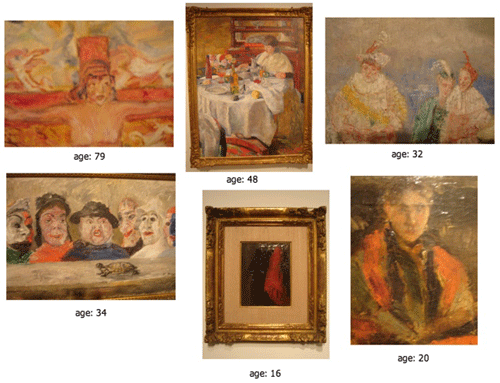
Then came the game called: chart the retrograde interval in the artist's life. Somewhere in the middle, he retreated to conventional representation after an early precocious and a later cantankerously felicitous imagery.
Alright. Cool.
Time to jet.
*
*
*


As the sun set, we found the site of Beth Campbell's public art installation.
Beth simulated an infinity mirror in an empty storefront, suggesting a travel agency from the Twilight Zone peppered with self help maxims and the allure of vacation get aways. The fabrication of the additional storefronts were excellent and yet hand made. After a while, the experience of the work becomes a search for anomalies. The jade palnt has different leaves, the ceiling tiles are not mirrored, the stainless steel of the door casing ripples the way foil does.

As Beth talked, I flipped open my camera hoping to capture her description of her own work. But two beats into the filming, she took a sidelong glance and demmanded that I stop then and there.
OK. No problem.
But why would an artist not want the dissemination of their thoughts/works?

After the after-party at a local bar, on our way to rendezvous with Joanne Greenbaum and significant other Bobby in TriBeCa for sushi, Aaron and I stopped by Beth's work to see the neon in full glory.
Walking the streets, a Spring night in New York.
On the way back to the hotel, we rendezvoused with Doug Henders. More beers and then the cigarettes at another cool bar on the street. We talked about his recent trip to Germany, of the scene in K?ln and Berlin, of art fairs in Dubai and where all this was going.

Two studio visits across the river this day.
Gilad Efrat had recently matriculated through Houston's Core Program as Aaron did back in the day. An Israeli who turned away from academia to recommit himself to art studio practice, he moved to Greenpoint (across the river north of Brooklyn, I think) to set up a studio and get all fruitful about it.

Gilad said he lays paint down in two shades and removes it with rags to render from dark to light. But how did he get such straight edges in this painting?


The themes that we chatted about sounded familiar. Gilad chooses imagery that is dark, that dwells on devastation and distress. We talked about how such conversations in Europe tend to content exclusive of technique and how it is al reverse here in the states. I asked about what Gilad thought about Mark Tansey and how his (Gilad's) technique intersected/informed the content that I perceived earlier. Is there a critique of humanity here? I asked him what is probably the most irritating question one can ask in the studio: what about that detrius that you are about to throw away, would you consider that art, a parallel project (I love the notations, the dwelling within of his prepratory sketches/gridded fotos)? Gilad was a gentleman as he answered with a generous positve.
Aaron asked about the time to produce each work, and did Gilad ever get the counsel in art school to be able to scale up and employ legions to produce work in size and quantity in order to shock and awe the artworld marketplace. Yes of course, Gilad said and he was wary about his apparent willingness to flout the unwritten mandate to operate a factory in the corporate executive manner. He couldn't imagine passing off the multitude of small creative leaps that occur between the gridded photocopies and the painting. For Aaron and I, the subject had become a worry stone that was passed hand to hand for 72 hours.
Quality time compressed in pulsed bursts. We called up Jim Butler and he was kind enough to pick us up to drive us to Ridgewood to see his new studio.

Jim shows with me at our gallery in Berlin, Andr? Buchmann Gallery near Checkpoint Charlie. Jim's practice centers on the creation of maquettes which he photographs and then paints that image in a loose yet realistic bravura manner. Recently, he has been hyper developing his maquettes, getting into glass and other exotic fabrication techniques at various glass studios on both coasts. He's become a Tim Hawkinson unbound, a world of material fabrication has opened up under him and I can't wait to see how his paintings reflect the intricate intensity of the discoveries he is reveling in lately.

Here, Jim describes how he makes the stands which prop up his maquettes.
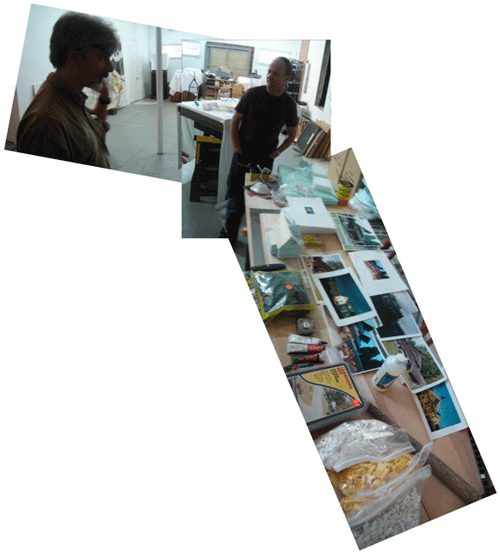
Look at his table tops. Jim arrays everything he has found so he can see them at once. Leggo parts that are made of a lost plastic fabrication, and he has more on special order from an obscure source. A model supply shop is in his neighborhood and he has kits to make waterfalls and model asphalt paved roads. He thought about modelling a conventional house, so he took his megapixel camera to shoot several prints of representative images. He spoke of hiring assistants to apply naive hands in order to reinterpret his research.
Talk about the atelier as factory! Jim has his personnel too, but they are all outsourced as vendors and suppliers or day labor with MFA's.
The density of information Jim delivered in that video is a snip of three hours that ranged from new material fabrication techniques to how the Brooklyn Queens area is gentrifying to the characters he meets who are in sole possession of lost knowledge.
My brain was beginning to jelly.

Afterwards, we hustled over to see Henry Taylor's show at the Studio Museum in Harlem.
(Sorry Henry, they wouldn't let me take pictures.)

On the way to Harlem, we stopped by Gagosian uptown to check out the Nate Lowman and Adam McEwen curated show "Beneath the Underdog". A perfect place to mount a historical survey of abject art, the corporate architecture of the Gagosian galleries was a suitable foil for a show such as this.

Aaron was interested in seeing the early work of Jeff Elrod, an old friend of his from the days back in the Core Program in Houston. Elrod's nascent artwork involved appropriating supergraphic paintings discarded in the trash back in the days that prefigured the contemporary preoccupation with fashion and hip edge.
I walked the galleries thinking about the Rosmund Felson show "Just Pathetic" curated by Ralph Rugoff back in 1990 just before "Helter Skelter"(A good short survey of abject art here). Abjection or Patheticism is no longer novel, its' history is long and pedigreed. The statement I read at the gallery desk was different from the press release you can download here at the Gagosian website. In the one I read, there was more of an exposition about the vertical (spiritual) and the horizontal (secular) and I thought about how historical the subject of abjection was becoming (can we all just move on now?); about how architecture was incapable of manifesting abjection, which illustrates a serious limitation (and ultimate nobility) of the kind of hippocratic oath architects labor under and how the general idea of the vertical/horizontal is also the armature of the political/cultural critique of the Left from the Right (examples here, here and here... not for the politically faint of heart, by the way.)

Most notable was the floor installation: a thick layer of sheet foam under a veneer of drywall. I don't know who the artist is, but I think it pushed the show over the edge into something remarkable. Try that, Frank Gehry!
No, wait... after five or ten years, the IAC Center will look just like this.


After all this, we rolled in to the Rental Gallery show late, and Joel Mesler's significant other, Allison Chernick promptly reminded us of our infraction with a sweet smile as we walked through the door. I think I'll let the video tell the story:
Later, Professor Winkler gave a speech to christen the event:

The inaugural show was a success after all; after all the doubts and backbiting by people who wouldn't let Joel evolve into another arena, another identity; after the self doubts and over analysis and too many minutes on the cell phone assessing whether it was crazy to take on New York; after all the talk in ChinaTown LA about whether Joel was making a smart move to the other coast, whether New York was over and incapable of providing a home for a young gallery; after the skepticism about the viability of Joel's iconoclastic business model that merges too closely with art practice itself. The question of whether Rental NYC would die in the cradle has been settled: the baby is alive and well, fingers and toes intact.
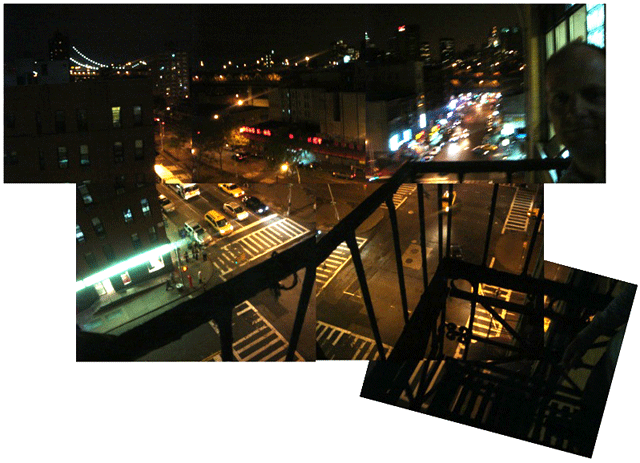
As we smoked the last cigarettes from my travel pack, a view of the city from the rusting balcony seemed to be an appropriate way to toast the ocassion. Thoughts of the many friends that I couldn't see or otherwise cram into the 72 hour schedule... a dull pain, and not in the arse it was.
And thoughts of how we would program the following day floated by. Oh, it'll be easy. Can we yet run into MOMA before we train back to JFK?
The after party: the bar we went to on the first night, this time packed twice as full of people, PS1 had their after party there too (what a distance!). More noise and shouting and great conversations. (Too much happened to relate here, the danger of slipping from journalism to gossip is an edge to be minded constantly. Time to move on....)

Aaron and I are perfectly matched as travel partners. He's too careful and I'm too careless. We ditched MOMA for breakfast with Joel and Phil around the corner of Rental Gallery, an echo of the morning coffee that we enjoyed in ChinaTown LA for so many years, keeping it real. Aaron was cutting the time down to the minute, and as we hustled back to JFK via the train, I was supremely relaxed, thinking that my flight took off after Aaron's. Aaron missed his flight by a mere minutes and lo, as I bellied up to the counter, I realized just how pathetic I am (Beneath the Underdog, indeed): I misread the flight information, mistaking the arrival time for the departure time. I totally missed my flight too!
We each returned home on later flights, by the way. The goof wasn't big enough to blow up the good vibe generated in the past 72 hours.
*(The answer to the Louie Kahn question: "...in compression...")
*2 (Postscript) I liked ending that section with the Oliver Stone line so much, that I'll add these second thoughts here:
Ouruosseff's reminder to Gehry suggests and assumes several things: that all you need is a strong idea and the details will take care of themselves, that Gehry's fine disregard for finish was intentional (probably so), that the appearance of elegance signals a dissapation of anarchic energy, that anarchic energy is synonymous with vitality, that the disregard he detected in the service stair shaft is different in degree with the rest of the building (much of the building is a folded curtain wall whose edges are gathered behind into his favorite service core like Balzac gripping his garment below his chin, his delight is the shabby way all the systems meet together). That's fine in a private realm, but as one approaches the public realm, there is such a thing as duty and service that binds service professionals, the very spot design and the fine arts diverge. Artists can live the dream, but architects (and doctors and lawers) cannot and should not confuse dreaming for living. It is the presence of that frame that helps keep the score ("Frame Narrative", indeed, Jason Meadows!).
I think the abject detailing arose as a virtue slavaged from the low price point advantage intrinsic to contemporary construction. I think it is the milk of human kindness to lift up your fellow man and spare them the gutter. I think artists and architects don't get along for this very reason. Artists have the license to sail over the edge, but if architects don't keep their feet planted in the ground, people might die... or live a degraded life. It's important to know when one is living and when one is dreaming --for to confuse the two, wretched insanity lies that way.
Contrairily, I remember a recent conversation with Mark McManus, a kind of architect who worked for Jorge Pardo and now for an old friend, architect Rick Corsini here in LA. Mark came from CalTech, an engineer and he jumped into architecture, designing buildings for Pardo's atelier. So Mark has a unique vantage point on the cats and dogs antipathy between artists and architects. Mark said that the problem with architects is that they fetishize their door details (a reference to the construction documents), that they have been derailed by the formalism of professional practice. Fair enough. The systems and processes of contemporary building do tend to acquire a life of their own, similar to Eisenhower's legendary warning about the military-industrial complex. Then again, it is our legal establishment which sorely lacks tort reform that has placed a critical stress on the importance of construction documents as a signal legal document that is instrumentally used to arbitrate disputes between owner and builder.
This is an age-old dispute, but I think much can still be done in bridging the parallel worlds of archtiecture and art.
May 14, 2007
New Yorked

It was a great weekend.
Brain turned to jelly.
Legs rubberized from speed walking.
Ears ripped from noise pollution.
Vocal chords shredded.
Eyes bugged out, bleary.
Wonderful.
The blog sac is filled to strain, veins bulging.
An avalanch to come soon.
May 10, 2007
NYNY
One of the openings that we will vector into this weekend will be Joel Mesler's inaugural show at Rental NY:

Featuring artists from galleries that will exhibit at RENTAL throughout the year:
BARA
SIMON BEDWELL
JUSTIN BEAL
RAFAL BUJNOWSKI
ANDRE BUTZER
CHARLES KARUBIAN
WILL FOWLER
KATIE GRINNAN
THOMAS GROETZ
ANDREW HAHN
THOMAS HELBIG
EVAN HOLLOWAY
MARCEL HUEPPAUFF
JO JACKSON
CHRIS JOHANSON
PETER KLARE
MAJA KOERNER
ELI LANGER
JASON MEADOWS
R.H. QUAYTMAN
RY ROCKLEN
FRANCES SCHOLZ
MARKUS SELG
ASTRID SOURKOVA
KIRSTEN STOLTMANN
PHIL WAGNER
JOHN WILLIAMS
THOMAS WINKLER
ULRICH WULFF
May 9, 2007
Ralph and Patrick

Team LA Packing and Crating, Ralph is a born leader. Serious and purposeful, he was careful to take the time to instruct young Patrick in the fine art of handling fine art. Pim pam poom, the paintings were rigged with struts and screwed into the walls and bed of thier truck just as the afternoon sun cranked into superhot global warming mode. As the temperature went up, the workload smoothed out and the professional tension eased into a genial handshake as they finished the job.
And young Patrick, he let me shoot his tats to share with the world:
1, 2, 3, 4, 5, &6.
New York This Weekend

I'll be in Manhattan this weekend, hanging with Aaron from Houston and Joel, who is opening his new gallery in another ChinaTown.

Much more to come...
Shipping Day

Yesterday, I boxed the works on paper (WOPS), like eggs in a carton they are.
Today, a crew from LA Packing and Crating will come in to pick up the paintings. It should be interesting to see the big painting peeled apart after all this time.
May 7, 2007
Title Time

What follows is a list of recent works on paper, with titles hyperlinked.

A Month of Paintings."
WOP 01-07
2007
Oil on Paper
18"x15"

The Person I Thought I Was.
WOP 02-07
2007
Oil on Paper
18"x15"

Say Nothing. Say Nothing?
WOP 03-07
2007
Oil on Paper
18"x15"

Precisely So, Precisely So.
WOP 04-07
2007
Oil on Paper
18"x15"
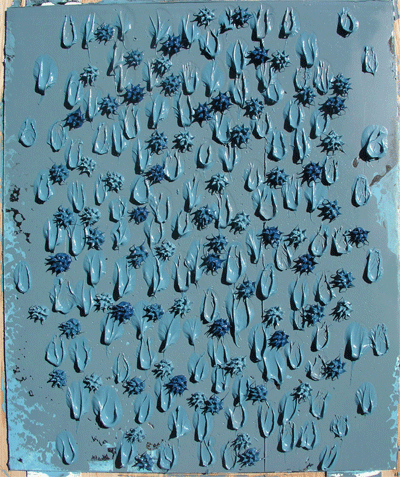
Passed in Whispers Among the Crowd
WOP 05-07
2007
Oil on Paper
18"x15"

Xenophon
WOP 06-07
2007
Oil on Paper
18"x15"

The Only Trace Left is Ash.
WOP 07-07
2007
Oil on Paper
18"x15"

Smaller Footprints
WOP 08-07
2007
Oil on Paper
18"x15"

Sometimes the Beautiful
WOP 09-07
2007
Oil on Paper
18"x15"

Again with Feeling.
WOP 10-07
2007
Oil on Paper
18"x15"

Clouds Swirl Around It.
WOP 11-07
2007
Oil on Paper
18"x15"

My Longwindery
WOP 12-07
2007
Oil on Paper
18"x15"

A Kind of Internecine War
WOP 13-07
2007
Oil on Paper
18"x15"

Moments of Weakness, Moments of Fortitude
WOP 14-07
2007
Oil on Paper
18"x15"
Open Studio Saturday

Much fun was had.
It could have been funner.
The whole shebang was thrown together hastily, I must admit.
Time for me has lost all slack.
Even so, It was gratifying to see so many friends come by to see the work.
May 4, 2007
May 3, 2007
Kim Jong Il, The Illmatic's Journal

The illmatic popped up three times in July of 2006.
Ever vigilant, fan that I am.
Ahora

I wasn't happy with the montage I took and assembled on the fly as I finished the last painting for the show in Tokyo, so I took my Photoshop blur tool and dialed it up to 100% and torched the offending portions of the image until I felt better.
As an old school buddy (Marcus Adams) said: "To get anything done in the studio, you have to let your other life burn a bit." And so I have. I'll be picking up teh pieces in the coming days, revving up the hablabla on this blog as I go.
Cropped portion here.
A bigger splash here.
Please Stand by...
Heads Up
It's about time.
I've been deadheading for sometime here in the studio, monomaniac that I am. Down at the razor edge of my calendar, I marvel at the thought --that once I had thought-- that I had beaucoup time to prepare for this show in Tokyo. And now here I am without an hour to spare.
I wanted to send this post up as a general invite to the studio to see the paintings before they get shipped out next week for Japan. Around six pm this Saturday, I'll have a few beers on ice for whoever wants to show up and share a toast with me then.
More to come.



